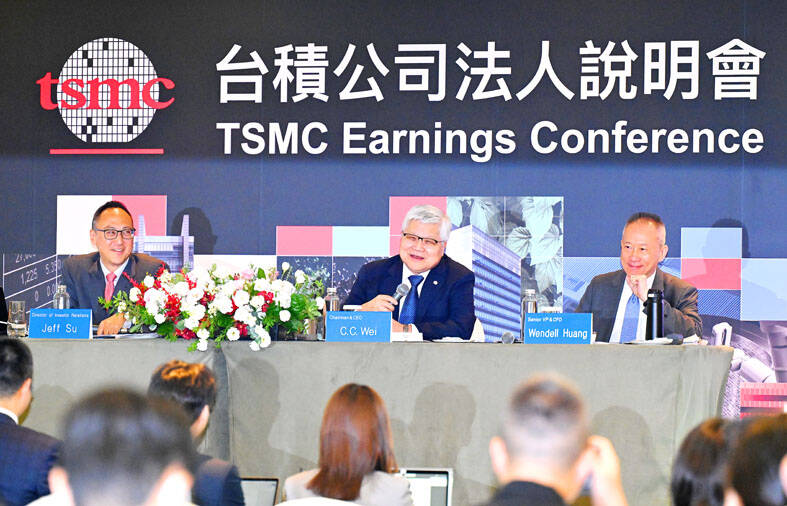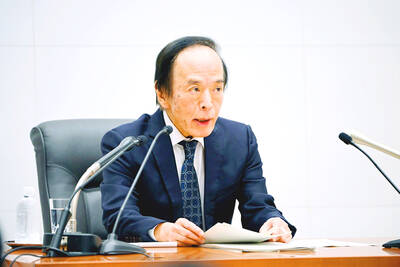Taiwan Semiconductor Manufacturing Co (TSMC, 台積電), a major chip supplier to Nvidia Corp, yesterday raised its revenue growth forecast for this year to 30 percent in US dollar terms, thanks to exceptionally strong demand for artificial intelligence (AI) and high-performance computing (HPC) applications.
The new revenue growth forecast surpasses the 25 percent expansion estimated by TSMC three months ago and beat almost all industry analysts’ expectations.
Booming AI demand helped propel the chipmaker’s net profit by 60.7 percent last quarter to a record high of NT$398.27 billion (US$13.54 billion), from NT$247.85 billion a year earlier. That represented a sequential increase of 10.2 percent from NT$361.56 billion.

Photo: Liao Chen-hui, Taipei Times
“The demand for AI is getting stronger and stronger, if you pay attention to what the US$4 trillion company’s CEO said,” TSMC chairman and chief executive officer C.C. Wei (魏哲家) told an investors’ conference in Taipei.
Wei was referring to Nvidia CEO Jensen Huang’s (黃仁勳) comments on AI demand.
“Recent developments are also positive to AI’s long-term demand outlook. The explosive growth in token volume demonstrates increasing AI model usage and adoption, which means more and more computation is needed, leading to more leading-edge silicon demand,” Wei said.
Robust AI and HPC demand is leading to supply constraints of TSMC’s 3-nanometer and 5-nanometer chips, as well as demand for its advanced chip-on-wafer-on-substrate packaging capacity, Wei said.
Last quarter, 3-nanometer and 5-nanometer chips contributed 60 percent to TSMC’s total revenue.
“We are working very hard to narrow the gap between demand and supply,” Wei said.
TSMC expects 3-nanometer chip supply constraints will last for several years.
The company’s revised revenue growth forecast did not factor in potential increases from Nvidia’s H20 chips after the US this week removed the export restrictions on such chips to China.
“We have not received the signal yet,” Wei said. “But certainly, this is good news... China is a big market and my customers can still continue to supply the chips to the big market. It’s very positive news for them and in return it’s very positive news for TSMC.”
TSMC expects revenue in the third quarter to expand to between US$31.8 billion and US$33 billion, representing about 8 percent growth sequentially or 38 percent annually. That factored in the negative impact of a stronger New Taiwan dollar against the US dollar.
The chipmaker assumed that the NT dollar would appreciate 6.6 percent against the greenback this quarter to an average of NT$29.
Gross margin would drop to between 55.5 percent and 57.5 percent this quarter from 58.6 percent in the second quarter, TSMC said, adding that the NT dollar’s appreciation would reduce gross margin by about 2.6 percentage points.
The forecast also includes the gross margin dilution from its overseas fabs in the US and Japan, it said.
To hedge foreign exchange risks, TSMC injected US$10 billion into its fully owned subsidiary TSMC Global, which effectively reduced the company’s US dollar exposure during a period of rapid NT dollar appreciation, the company said.
TSMC booked non-operating income of NT$29.61 billion last quarter, up from NT$23.82 billion in the first quarter.
The chipmaker yesterday that the long-term gross margin target of 53 percent and even higher remains to be achievable, despite unfavorable foreign exchange rates and tariff policy uncertainty.
TSMC yesterday said it is speeding up chip production schedule by several quarters at its factories in Arizona to cope with robust demand from its leading US customers.
TSMC counts US major technology companies from Nvidia, Apple Inc and Advanced Micro Devices Inc to Qualcomm Inc as its key customers.
TSMC plans to build six advanced chip manufacturing fabs in Arizona to create a chip manufacturing cluster, with the third fab under construction. The third fab is to utilize the company’s 2-nanometer and more advanced A16 process technology, with 3-nanometer and 4-nanometer technologies used at its second and first fabs.

Taiwan Semiconductor Manufacturing Co (TSMC, 台積電) last week recorded an increase in the number of shareholders to the highest in almost eight months, despite its share price falling 3.38 percent from the previous week, Taiwan Stock Exchange data released on Saturday showed. As of Friday, TSMC had 1.88 million shareholders, the most since the week of April 25 and an increase of 31,870 from the previous week, the data showed. The number of shareholders jumped despite a drop of NT$50 (US$1.59), or 3.38 percent, in TSMC’s share price from a week earlier to NT$1,430, as investors took profits from their earlier gains

In a high-security Shenzhen laboratory, Chinese scientists have built what Washington has spent years trying to prevent: a prototype of a machine capable of producing the cutting-edge semiconductor chips that power artificial intelligence (AI), smartphones and weapons central to Western military dominance, Reuters has learned. Completed early this year and undergoing testing, the prototype fills nearly an entire factory floor. It was built by a team of former engineers from Dutch semiconductor giant ASML who reverse-engineered the company’s extreme ultraviolet lithography (EUV) machines, according to two people with knowledge of the project. EUV machines sit at the heart of a technological Cold

TAIWAN VALUE CHAIN: Foxtron is to fully own Luxgen following the transaction and it plans to launch a new electric model, the Foxtron Bria, in Taiwan next year Yulon Motor Co (裕隆汽車) yesterday said that its board of directors approved the disposal of its electric vehicle (EV) unit, Luxgen Motor Co (納智捷汽車), to Foxtron Vehicle Technologies Co (鴻華先進) for NT$787.6 million (US$24.98 million). Foxtron, a half-half joint venture between Yulon affiliate Hua-Chuang Automobile Information Technical Center Co (華創車電) and Hon Hai Precision Industry Co (鴻海精密), expects to wrap up the deal in the first quarter of next year. Foxtron would fully own Luxgen following the transaction, including five car distributing companies, outlets and all employees. The deal is subject to the approval of the Fair Trade Commission, Foxtron said. “Foxtron will be

INFLATION CONSIDERATION: The BOJ governor said that it would ‘keep making appropriate decisions’ and would adjust depending on the economy and prices The Bank of Japan (BOJ) yesterday raised its benchmark interest rate to the highest in 30 years and said more increases are in the pipeline if conditions allow, in a sign of growing conviction that it can attain the stable inflation target it has pursued for more than a decade. Bank of Japan Governor Kazuo Ueda’s policy board increased the rate by 0.2 percentage points to 0.75 percent, in a unanimous decision, the bank said in a statement. The central bank cited the rising likelihood of its economic outlook being realized. The rate change was expected by all 50 economists surveyed by Bloomberg. The